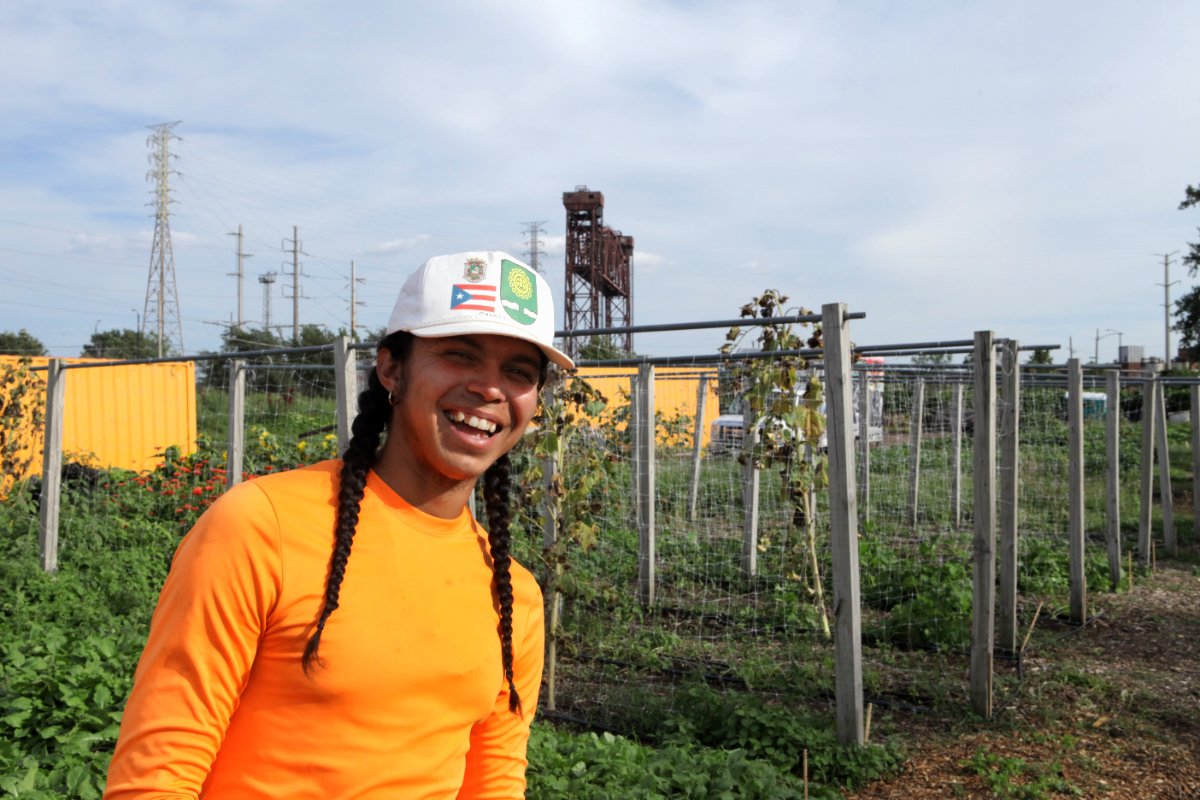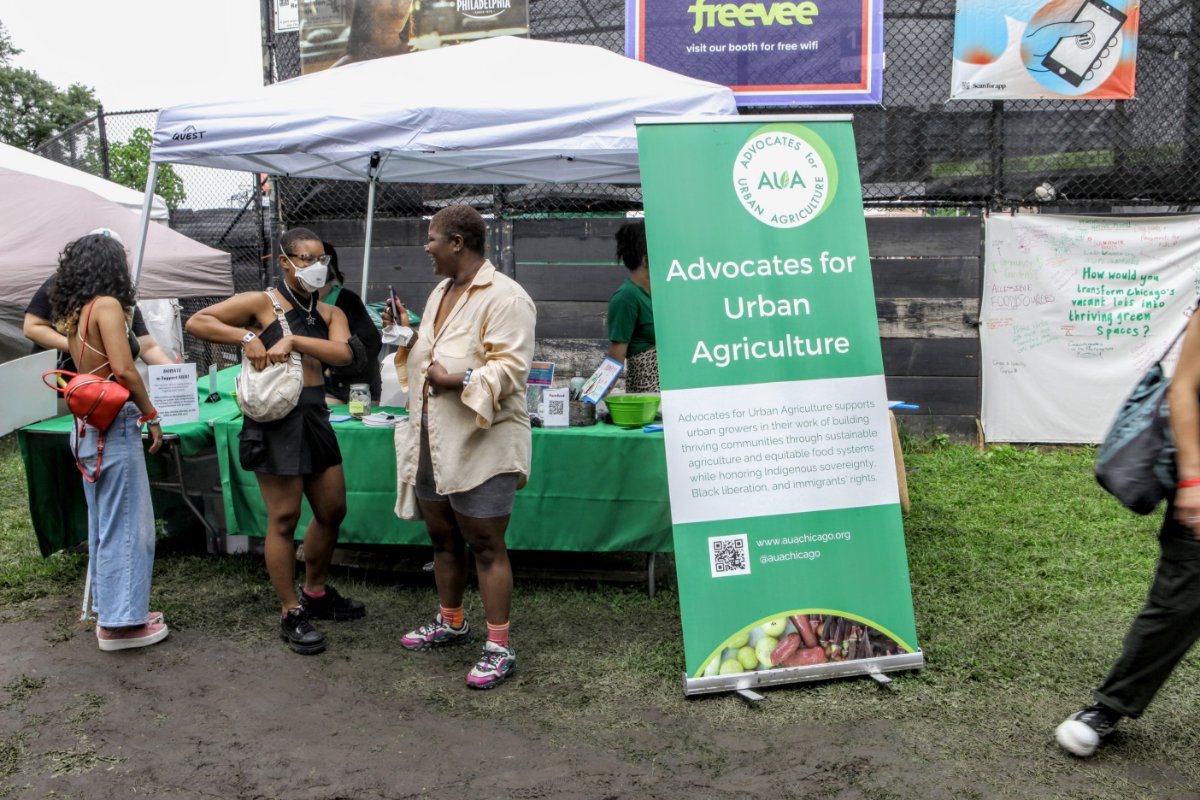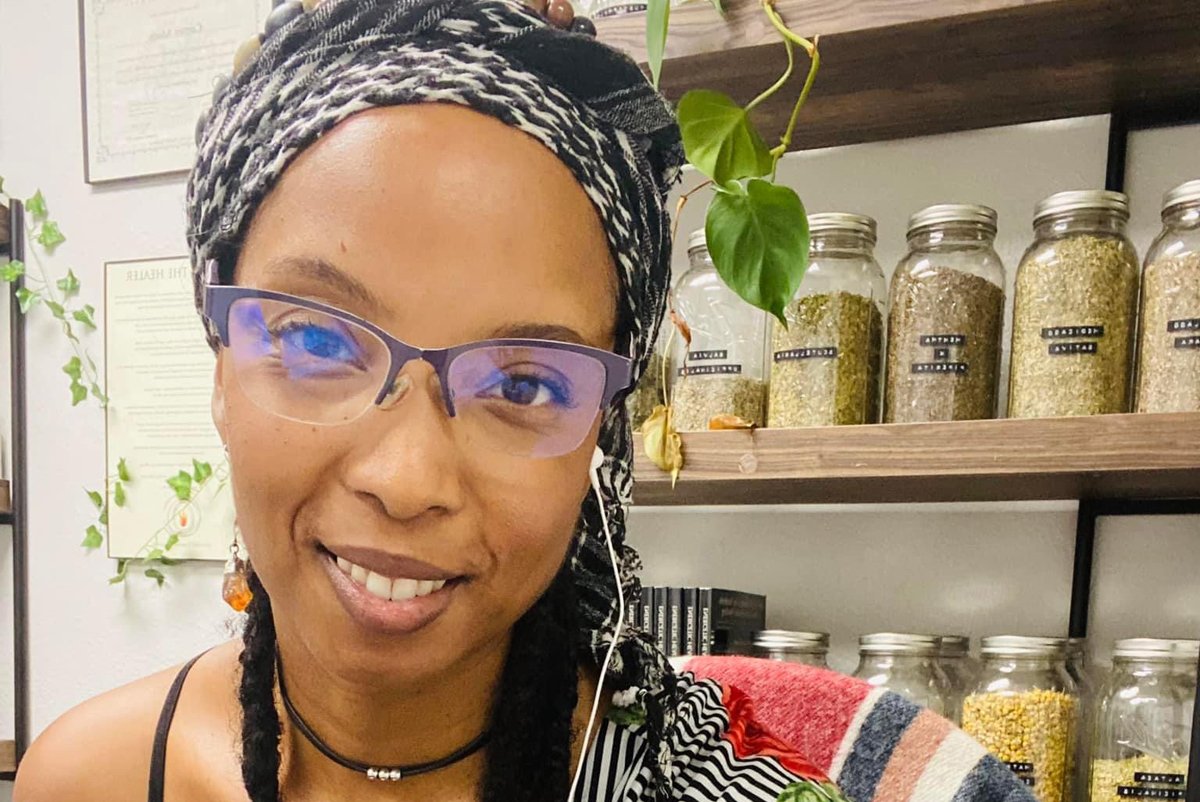Surrounded by the pollution resulting from decades of steel production, a community garden is providing relief to Chicagoland communities.

Surrounded by the pollution resulting from decades of steel production, a community garden is providing relief to Chicagoland communities.
January 26, 2023

Xavier “X” Colon stands in the fields at South Chicago Farm. (Photo by Paul Gordon)
The steel mills on the Southeast side of Chicago were once an economic engine that allowed workers to put food on the table for their families. But that financial security came at a cost. In its wake, the industry has left asthmatic children, brownfields, and slag-filled marshes.
In the face of those environmental injustices, Chicago’s Southeast side community has come together to create green spaces that educate and feed residents and serve as meeting points. With the help of organizations like Advocates for Urban Agriculture (AUA), community-focused environmental nonprofits like Urban Growers Collective (UGC) are spearheading efforts to make green spaces more just and equitable in areas that have been historically divested by the city—and reverse the harm that has been done to the land and its residents.
UGC runs the South Chicago Farm, an urban farm in the Southeast that offers farm-fresh food while engaging the community and teaching farm skills. A mile short of the Indiana border and across the street from Steelworkers Park (formerly part of the U.S. Steel Complex), the farm sits within Clara Schaffer Park, which opened in 2015 as a 14-acre public space.
Occupying half of the park, the farm is outfitted with greenhouses, a community garden, a burgeoning orchard, rows of plant beds, and goats. The garden produces thousands of pounds of fresh food which are distributed to the community by a mobile farmers’ market, a converted bus that acts as a “produce aisle on wheels,” traveling to under-served communities and setting up shop near frequented neighborhood locations like schools, health clinics, and community centers. Like urban farms elsewhere in the U.S.—in Pittsburgh, Oakland, D.C., and NYC—the farm is stepping up to serve the unmet needs of its community.
“Green spaces are places for us to gather and build community,” says Bea Fry, AUA’s development and strategic partnership steward. “It is a place to convene, just chat it up with one another, and discuss community issues.”
Working both at the city level and in the Chicago region, the group works to support urban farmers and the policies that make their work possible. At the root of it, says Fry, AUA’s work is to reimagine what it means to be in relation to nature and one another. “The things we put in our body, whether it be the air that the trees produce, the food that we are growing—these green spaces and farms directly nourish ourselves, our families, and community members,” Fry says. “We have the opportunity, and we are already creating something renewed.”
Today, the South Chicago Farm runs like a well-oiled machine, fueled by community members, farmworkers, and volunteers attending to the crops. But to truly understand how remarkable—and needed—the South Chicago farm is, one needs to understand how destroyed the land there was just a few decades ago.
A Polluted History
For over a century, Chicago was the industrial powerhouse of the Midwest. Railroads found a central axis in the city, and heavy industry flourished.
The Southeast side of Chicago saw an outburst of steel production during World War II. At one point, its manufacturing plants accounted for 20 percent of all steel made in the U.S. and 10 percent globally.
Steel is a dirty industry that produces a lot of pollution from fuel needed to heat up the metal. The Southeast side of Chicago was an attractive spot for steel because of its large labor force, its access to the Calumet River and Lake Michigan, and its wetland ecosystems, which provided an easy place to dump waste.
“We are left with the bodily remnants of harm caused by the city and industry. With green spaces, we are trying to create alternatives and a healthy future.”
“The Southeast side was a really marshy area, and it was looked upon as a challenge to overcome,” says Rod Sellers, director of the Southeast Chicago Historical Museum.
Entire lakes and wetlands were filled in with solid waste and slag, the stony waste matter that is separated during the steel refining process, up to 60 feet deep. And while slag itself is inert, it can contain cyanide, arsenic, and a host of toxic heavy metals.
Since the peak of steel production in the ’50s and ’60s, the mills saw a steady decline. Many factories were abandoned and became vacant lots, and new polluting industries replaced closed factories as the city of Chicago maintained its permissive zoning laws.
Recently, for example, General Iron tried to move its recycling facility from a more affluent part of the city to the Southeast side. Residents pushed back and the request was denied, but the fight continues in court. And despite the shifting landscape of industrial production, the environmental and social burdens have persisted and taken shape in new and harmful ways, such areas with very low access to fresh and healthy foods.
“We are left with the bodily remnants of harm caused by the city and industry,” says Fry of AUA. “With green spaces, we are trying to create alternatives and a healthy future.”
A Community-Driven, Justice-Focused Urban Farm
Government pledges to clean up contaminated and vacant properties have been slow to materialize, largely leaving the community to create its own solutions. Novel strategies to carve out niches of plant life through urban agriculture have served as ways for communities to make use of these spaces.
AUA is a BIPOC, queer grower-led organization which operates with a horizontal leadership model. They seek to create the policies and internal structures to actualize their dream of prioritizing growers of color. Some of their work includes supporting growers with hydrant access to water plants and co-leading an urban agriculture working group with the City of Chicago’s new Food Equity Council.
They have also launched their third cohort of a farmer-to-farmer mentorship program that provides community, knowledge sharing, and mentorship to dozens of emerging growers each year. On top of that, AUA distributed more than $500,000 in grant funds to stewards throughout the region for COVID-19 support, capacity building, and solidarity funds.
Meanwhile, the South Chicago Farm—which, in the absence of soil remediation support, has relied on trucked-in soil to cover the existing ground, and now runs a large composting setup to keep the soil healthy—has been viewed as a model for urban farming and industrial renewal. In fact, United Nations Ambassador Linda Thomas-Greenfield visited the farm in August to learn about solutions to food insecurity.
The UGC helps the community get in touch with the farm by hosting a Youth Corps. The farm has paired up with an after-school program that engages more than 180 youth annually. The hands-on STEAM curriculum is centered on teaching students practical skills of harvesting and cultivating produce and working as a part of a team. The South Farm also hosts a variety of programming for people of all ages, from drop-in volunteer workdays to an herbalism apprenticeship.
“I want folks to feel part of our work, whatever they are doing to work with nature and to feed themselves, family, and community,” says Erika Allen, a co-founder and the CEO of UGC. “It is a powerful juxtaposition to have a farm on the Southeast side, across from all kinds of degradation and ongoing environmental justice battles.”
Paige Tobin started as a volunteer at UGC and found peace of mind at the urban farm during the early days of the pandemic. “This place doesn’t make sense without community,” says Tobin, now the farm administrative coordinator at UGC. “You can’t grow this without critical buy-in from community members.”
Xavier “X” Colon, a UGC farmer-educator, sees the site, above all, as about helping residents heal from historical divestment and pollution. “There are hundreds of different ways to fight climate change. I think the main solution is helping our people heal, and that’s what we do at this farm,” he says. “Seeing the whole production from a seed to a flower to a fruit is healing, and having the youth in the community experience that is healing, and they can pass that on. I think we ought to fight for these kinds of futures.”
And, he adds, the land benefits as well. “The kind of regeneration work of creating a flourishing garden is healing not only for the youth in our community and the farm workers like myself, but also the land.”
While South Chicago was the first urban farm that UGC managed, the organization has sites all around the city, and they are expanding with the new Green Era Urban Energy Campus development in Englewood. The campus is a multi-use complex that is still being realized, but it hopes to open synchronously as a compost facility, farmers market, greenhouse, education center, and nature area all on one site.
The mission is to create more sustainable communities by supporting local food production through better management of biodegradable waste and access to soil.
Broadening the Mission
AUA advocates for water access, land access, and soil remediation, which can be a long, slow process for growers. The organization is working to demystify these processes while simultaneously moving toward creating simpler, more equitable processes prioritizing BIPOC growers.
In the next year, AUA will continue their advocacy and technical assistance work through water access support and an initiative of comprehensive soil testing for Chicagoland growers to help them better understand what sort of soil they are planting on. AUA is contracting with stewards to act as soil scientists and water access technical assistance specialists. These positions will work with the farmers to test soil for contaminants for free and work with soil experts who will give site specific soil health recommendations. This is part of an effort to better understand the city’s soil health so they can continue to inform advocacy efforts at the city level.
Last year, AUA had a presence as a nonprofit partner of the annual, multi-genre Pitchfork Music Festival. AUA received a portion of the VIP ticket sales, in addition to a donation received through a partnership Pitchfork set up with Pizza Friendly Pizza, totaling to a little over $5,000.

Advocates for Urban Agriculture hosting an informational booth at the Pitchfork Music Festival. (Photo by Paul Gordon)
At the festival, AUA had a tent with volunteers and workers and provided a backdrop canvas on which attendees were asked to write or draw a response to the following question: “How would you transform Chicago’s vacant lots into thriving green spaces?” At the end of the festival, the group created a tapestry of ideas attendees shared.
AUA’s Fry says we can all agree that we have to eat, that food is a fundamental human right, and that we all deserve equal access to this right.
“It’s important that we have a space at this music festival, because every single attendee eats, and there are farmers right here in the city providing food every day,” they say. “AUA is here to support them and make that happen.”
This article was updated to reflect Bea Fry’s correct pronouns; we regret the error.

September 4, 2024
By paying top dollar for milk and sourcing within 15 miles of its creamery, Jasper Hill supports an entire community.
September 3, 2024

August 27, 2024

August 26, 2024

August 13, 2024

Like the story?
Join the conversation.